The Xiaomi 11T & 11T Pro Review: Two Chips, With a Battery Focus
by Andrei Frumusanu on September 15, 2021 9:00 AM EST- Posted in
- Mobile
- Smartphones
- Xiaomi
- Xiaomi 11T
- Xiaomi 11T Pro
System Performance
The comparison of the Snapdragon 888 to the Dimensity 1200 is interesting as we don’t tend to get to compare MediaTek devices very often. In theory, the Snapdragon has much more oompf to it given its higher performance X1 core, but things also depend on software.


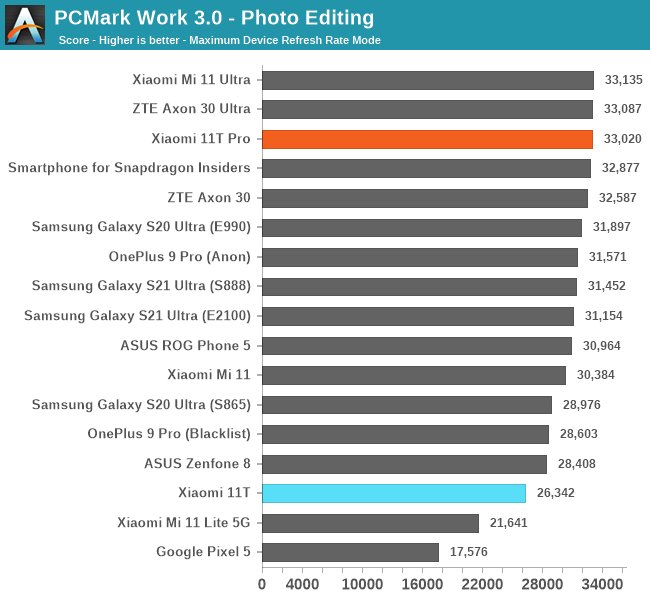
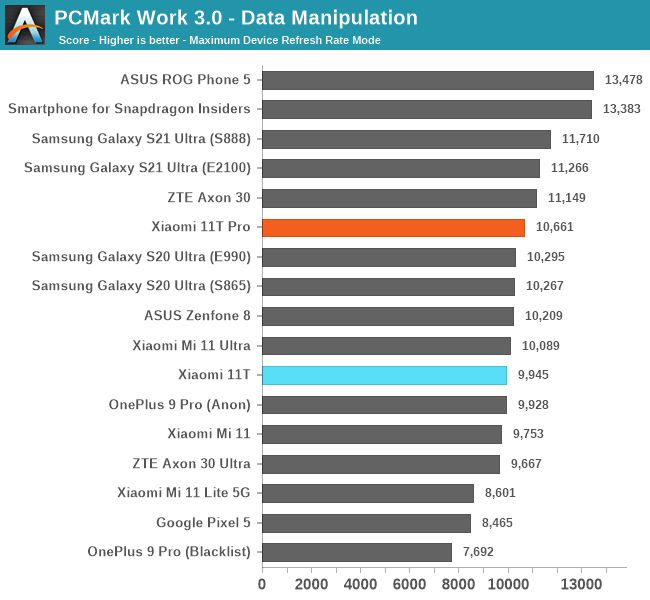
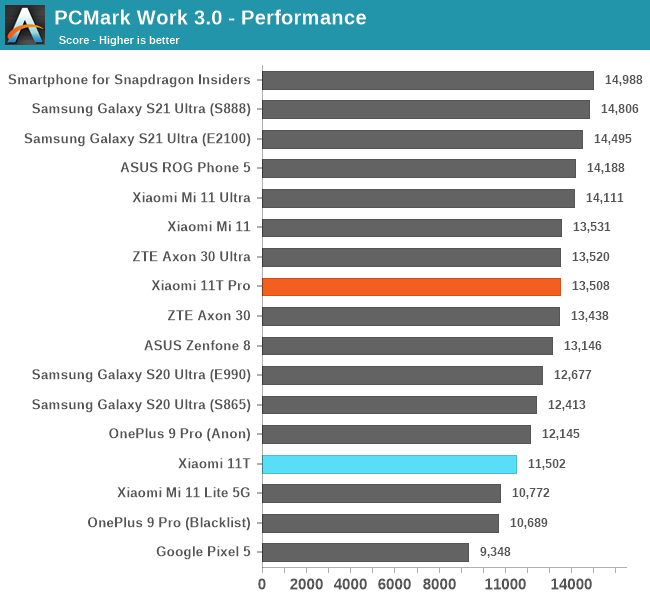
In PCMark, as expected, the Qualcomm powered 11T Pro has no issues in performing quite ahead of the MediaTek powered 11T. It seems that the SoC as well as software stack allows for more aggressive responsiveness on the larger SoC – which is to be expected.
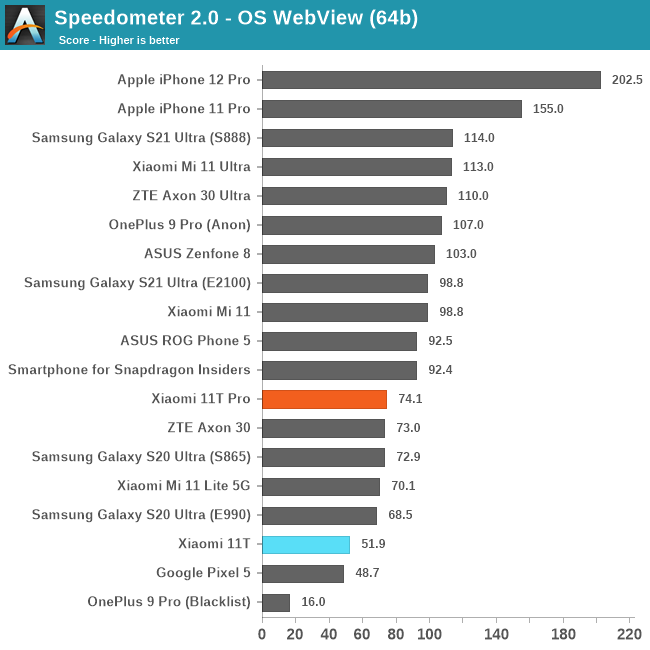
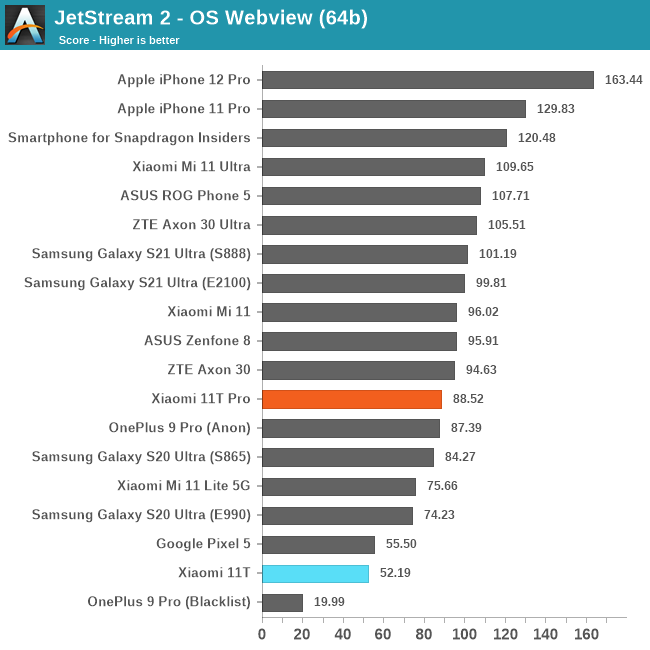
When it comes to the web tests, we also see the 11T Pro easily outperform the 11T, by quite some significant margins even.
What’s a bit weird here is that both devices are actually performing below expectations, and here is where things get very shady:
The Snapdragon 888 in the 11T Pro in these benchmarks is never using the Cortex-X1 cores of the SoC. Instead, pretty much the totality of the tests is being performed on the 2.41GHz A78 cores. If this sounds familiar to you, it’s because we saw some kind of similar behaviour on the OnePlus 9 Pro.
What’s happening on the 11T Pro is that indeed it seems any anonymous workload on the phone is mostly unable to be scheduled on the X1 cores, unless there’s multiple threads which causes spill-over. Without CPU affinity in my SPEC harness, the load gets also scheduled on the A78 cores. If I limit it to just the X1 core, it only goes up to 2.15GHz. In GeekBench, the ST workloads do go up to 2.84GHz even in an anonymised variant of the test, however in the MT load the X1 cores again are limited to 2.15GHz. The X1 cores are still being used here and there in scenarios such as opening apps, but otherwise rarely so.
I can’t really tell if it’s extreme battery optimisation or not, but it’s quite aggressive and the Snapdragon 888 here is definitely handicapped in terms of behaviour.
On the MediaTek Dimensity 1200, the chip fares normally in steady state workloads, however in more interactive workloads such as the above web tests, the DVFS and scheduling behaviour is all over the place with the chip not consistently having the workload on the performance core. I’m also seeing bursts of the other cores needlessly going up in frequency. In general, we don’t have too much experience with MediaTek’s latest software stack, so this would require a bit more investigation, but generally, the phone doesn’t perform quite as well as the raw CPU performance would indicate.
Both phones are fluid at 120Hz, and the 11T Pro is still very responsive, however the 11T doesn’t feel quite as fast.










41 Comments
View All Comments
beginner99 - Thursday, September 16, 2021 - link
Hence you should disable fast charging and only enable it when your really need it. Plus not go below 20% too often and not leave it plugged in at 100% overnight.philehidiot - Thursday, September 16, 2021 - link
Myself I have a balance between battery and lifestyle. I'm not rearranging my life around battery longevity and I've a local phone shop that does reasonably priced battery swaps. You lose waterproofing, though. I slow charge with a slow wireless charger overnight (to preserve the USB port which is a known weakness on my phone) and have "fast cable charging" disabled. So when I go on holiday, I take a normal wired charger and the super fast one. The super fast cable charging is enabled but there's no way of mixing it up as it's the only time I ever use that charger and I have to consciously get it. When you're in a rush, the last thing you want to do is mess around with charging options.It's not the most optimal solution for battery life, but I also bought a phone with a battery that would easily last a day and a half when I got it, so there is room to drop before it really impacts my routine.
I'll be very interested to see what this article has to say on the effect of fast charging on battery life. It's infuriating that people just aren't aware of the problems to the point that they'll actively challenge something that has been well established for decades - fast charging repeatedly damages batteries.
timecop1818 - Wednesday, September 15, 2021 - link
xiaomi makes a lot of USB power banks, so they should have experience with high charge/discharge battery cellsssdj - Thursday, September 16, 2021 - link
Xiaomi has a share in sunwoda, world's leading battery manufacturer on par with coslight.abufrejoval - Wednesday, September 15, 2021 - link
Well, it is becoming more and more difficult to achieve the miracles vendors want to sell and consumers want to brag about...But will consumers be unhappy with these devices, even when they are throttled to where they no longer burn their fingers (and the battery)? Probably not.
The main message for me is: Little benefit from new devices in terms of performance.
Limited battery life time, ever more fragile devices and limited software support unfortunately won't let us just keep our existing phones until things get interesting again.
GC2:CS - Wednesday, September 15, 2021 - link
Well thanks for your work an article on those FTL charging methods would be greatly appreciated.I do have a suspicion that something is wrong with "charges in 15 minutes and 120W in phone thing" when the basics are still lithium ions and cobalt oxide housing. They do not like high currents and high temperatures. And nobody talks about negatives. All I see is fanboys screaming "ur phone charges slower than a snail !"
So a thorough deep dive would be appreciated. Should I charge my notebook at 5W then ?
dragosmp - Wednesday, September 15, 2021 - link
Probably not at 5, but not at 120W either. For every battery chemistry and build quality there is a "maximum" charging speed for which there is no heat accumulation and no separator damage. If it's a "power" cell, aka a cell with a thinner and more permeable separator, then you can charge at higher power, but you get less Wh per volume. Power cells also tend to get higher self-discharge. At 5000mAh, so 5Ah, for an average 3.8V, 1C charging is 18W. 18W is surely safe, and probably somwere between 18 and 36W is safe too below 80% SoC. For more than that, it depends on the cell, heatsink/phone and charging curve - which is why I'm with Andrei on testing the battery inside the phone, as opposed to on a table with open airflow and maybe too keeping temps in check.Wrs - Wednesday, September 15, 2021 - link
There is already so much one can do with lithium and cobalt (or manganese sometimes).. what it boils down to is how good the design is and how well it's manufactured. Remember years back when we worried about whether 15W quick charging would lead to shortened lifespan compared to 5W charging? You could say back then designs were less advanced - production methods were not as refined, and the product has to be perfect btw, one mistake and a fire erupts in someone's pocket.I'm of course curious about how much degradation happens at 120w peaks compared to 15 or 25w. Someone will have to test that long-term. And then we'll have to ask whether that's significant or practically meaningful. Degradation is not really a fixed percentage; it's more like an added resistor to the battery. Draw high testing current and you'll see much higher % aging than if you draw low current. All that is relative to battery size. That's why Apple had that "fiasco" with performance throttling on older iPhones. Their battery designs tend to be smaller and more conservative (less cutting-edge). I will say I appreciate seeing a contrasting manufacturer who keeps pushing the edge - all this research prepares us for what we might see as standard tomorrow.
NextGen_Gamer - Wednesday, September 15, 2021 - link
Small (but funny typo): after making a point of talking about how Xiaomi has dropped the Mi branding from the 11T series, you then proceed to call them just that in the spec comparison table right afterwards hahaAndrei Frumusanu - Wednesday, September 15, 2021 - link
Thanks, I had written the header table before Xiaomi emphasised the Mi removal.